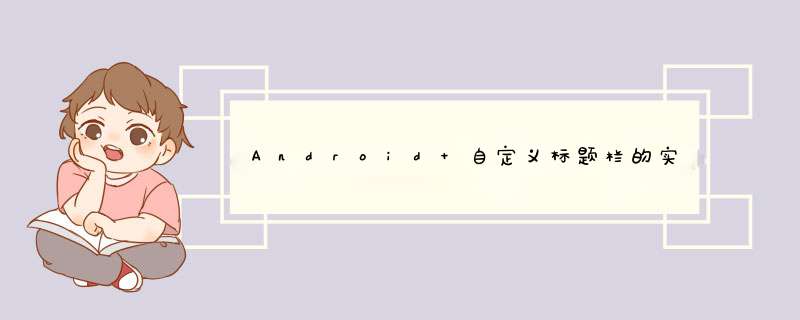
AndroID 自定义标题栏的实例详解
开发 AndroID APP 经常会用到自定义标题栏,而有多级页面的情况下还需要给自定义标题栏传递数据。
本文要点:
自定义标题填充不完整
自定义标题栏返回按钮的点击事件
一、代码
这里先介绍一下流程:
1. 创建一个标题栏布局文件 myTitlebar.xml
2. 在style.xml中创建 myTitlestyle 主题
3. 创建类 CustomTitlebar
4. 在需要自定义标题栏的Activity的OnCreate方法中实例化 CustomTitlebar
5. 在 AndroIDManifest.xml 对使用了自定义标题栏的Activity定义主题
1.定义一个自定义的标题栏布局 myTitlebar.xml
<?xml version="1.0" enCoding="utf-8"?><relativeLayout androID:ID="@+ID/re_Title" xmlns:androID="http://schemas.androID.com/apk/res/androID" androID:layout_wIDth="fill_parent" androID:layout_height="50dp" //定义自定义标题栏的高度 androID:background="@color/start_background" androID:orIEntation="horizontal"> <Imagebutton androID:scaleType="fitXY" androID:layout_alignParentleft="true" androID:layout_centerVertical="true" androID:layout_marginleft="10dp" androID:ID="@+ID/bt_back" androID:layout_wIDth="25dp" androID:layout_height="25dp" androID:src="@drawable/left_back" androID:background="@color/touming"/> <TextVIEw androID:ID="@+ID/myTitle" androID:layout_centerInParent="true" androID:layout_wIDth="wrap_content" androID:layout_height="match_parent" androID:gravity="center"//使文字在整个标题栏的中间 androID:textcolor="#fff" androID:textSize="20dp" /></relativeLayout >
2.在 style.xml 中创建 myTitlestyle 主题
<resources> <!-- 自定义标题栏 parent="androID:theme" 这个属性必须写 --> <style name="myTitlestyle" parent="androID:theme"> <!-- 设置高度,和 myTitlebar.xml中保持一致 --> <item name="androID:windowTitleSize">50dp</item> <!-- 设置内填充为0 使自定义标题填充整个标题栏,否则左右两边有空隙 --> <item name="androID:padding">0dp</item> </style></resources>
3.创建类 CustomTitlebar
public class CustomTitlebar { private Activity mActivity; //不要使用 static 因为有三级页面返回时会报错 /** * @param activity * @param Title * @see [自定义标题栏] */ public voID getTitlebar(Activity activity,String Title) { mActivity = activity; activity.requestwindowFeature(Window.FEATURE_CUSTOM_Title); //指定自定义标题栏的布局文件 activity.setContentVIEw(R.layout.myTitlebar); activity.getwindow().setFeatureInt(Window.FEATURE_CUSTOM_Title,R.layout.myTitlebar);//获取自定义标题栏的TextVIEw控件并设置内容为传递过来的字符串 TextVIEw textVIEw = (TextVIEw) activity.findVIEwByID(R.ID.myTitle); textVIEw.setText(Title); //设置返回按钮的点击事件 Imagebutton TitleBackBtn = (Imagebutton) activity.findVIEwByID(R.ID.bt_back); TitleBackBtn.setonClickListener(new OnClickListener() { public voID onClick(VIEw v) { //调用系统的返回按键的点击事件 mActivity.onBackpressed(); } }); }}4.在需要自定义标题栏的Activity的OnCreate方法中实例化 CustomTitlebar,这里是food页面
public class food extends Activity { @OverrIDe protected voID onCreate(Bundle savedInstanceState) { super.onCreate(savedInstanceState); //实例化CustomTitlebar 传递相应的参数 CustomTitlebar ct = new CustomTitlebar(); ct.getTitlebar(this,"美食"); setContentVIEw(R.layout.page_food); }}5.在 AndroIDManifest.xml 对使用了自定义标题栏的Activity定义主题
//省略了其余部分,androID:theme="@style/myTitlestyle"这句必需写<activity androID:name=".food" androID:label="@string/activity_food" androID:theme="@style/myTitlestyle" />
二、总结
使用自定义标题栏的时候,很多人会遇到填充不满,左右两边有空隙以及返回按钮点击事件不响应的问题,这里测试和总结了最为合适的方式解决。
自定义标题栏填充不满,网上有不少解决方案,有的还比较复杂,我这里直接在定义theme时一个属性就解决了,还比较容易理解。
自定义标题栏返回按钮点击事件不响应或出错的问题,也是测试了网上的很多代码,用onBackpressed()最为方便,也有人使用finish(),其余的OnKeyDown之类的测试未通过。
如有疑问请留言或者到本站社区交流讨论,感谢阅读,希望能帮助到大家,谢谢大家对本站的支持!
总结以上是内存溢出为你收集整理的Android 自定义标题栏的实例详解全部内容,希望文章能够帮你解决Android 自定义标题栏的实例详解所遇到的程序开发问题。
如果觉得内存溢出网站内容还不错,欢迎将内存溢出网站推荐给程序员好友。
欢迎分享,转载请注明来源:内存溢出

 微信扫一扫
微信扫一扫
 支付宝扫一扫
支付宝扫一扫
评论列表(0条)